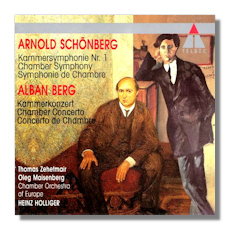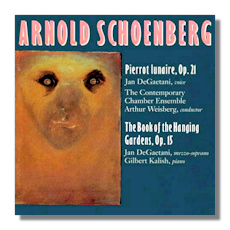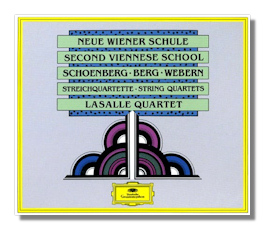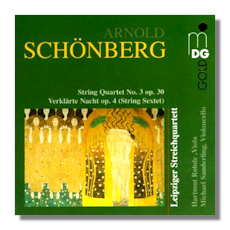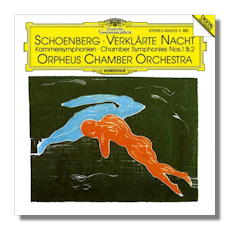
The Internet's Premier Classical Music Source
Related Links
-
Find CDs & Downloads
Amazon - UK - Germany - Canada - France - Japan
ArkivMusic - CD Universe
Find DVDs & Blu-ray
Amazon - UK - Germany - Canada - France - Japan
ArkivMusic-Video Universe
Find Scores & Sheet Music
Sheet Music Plus -
Recommended Links
Site News
Arnold Schoenberg
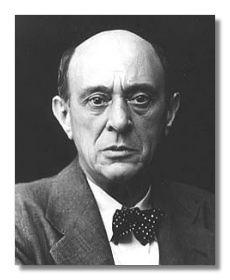
(1874 - 1951)
Arnold Schoenberg (September 13, 1874 - July 13, 1951) was one of the founders of musical Modernism, an incredibly influential figure from the early twentieth century to at least twenty-five years after his death – with Stravinsky, one of the two most influential composers of his time. Even those fundamentally antithetical to atonality were moved to see musical aesthetics very much as he did. As a composer, Schoenberg largely taught himself, sometimes relying on the advice of his friend, the composer Alexander von Zemlinksy. Zemlinsky's sister Mathilde became Schoenberg's first wife. The marriage came close to foundering when Mathilde left Schoenberg for an artist. She returned, but the marriage never recovered. Nevertheless, when she died in 1923, Schoenberg was devastated. Still, he remarried quickly, this time choosing the sister of the violinist Rudolf Kolisch, Gertrud. It was a love match.
From the early twentieth century, Schoenberg was considered a leading light of the younger generation, attracting the attention of no less than Gustav Mahler. He kept up a steady stream of composition, extending the language of the day as well as striking out in new directions. However, in 1912, he underwent an artistic crisis and for close to a decade completed no major new piece. For most of these years, he made very little money, mainly from private teaching, although he had achieved international fame. During World War I, he was rejected from military service for health reasons. However, his students were called up, and he had to stop teaching for a time.
The Twenties saw a change in his fortunes. He began to compose again, this time in a new compositional language he had worked out, which he called "the method of composing with twelve tones" – what today is known as dodecaphonic serialism. He founded the Union for Private Performance, a subscription organization dedicated to new music and intended only for interested parties, rather than for the general public. Orchestral works were given in chamber arrangements, and the composers played included Claude Debussy, Mahler, and even Charles Ives. He received conducting engagements in major European music centers, as well as several honors in Germany and in Austria. He was put in charge of the composition master class at the Berlin Academy of Art and elected (supported by Kurt Weill) to the Prussian Academy.
When the Nazis came to power in 1933, Schoenberg left Germany for France and, later, the United States, where he eventually settled in the Los Angeles area in 1934. Schoenberg, of Jewish family, had converted to Protestantism in 1898, but he never was formally religious. Nevertheless, he saw the swastika on the wall and got out – surprising, when one considers his unworldliness in practical matters. He also formally converted back to Judaism, mostly as a protest against anti-Semitism. He became a professor at UCLA and an influential teacher in the country. For composers, southern California became a major musical center, mainly because Schoenberg taught there. However, the United States proved hard ground for his music. His health, never robust, deteriorated sharply. Nevertheless, he felt so out of place that as late as the Forties, he still considered leaving for somewhere else. Health problems forced him to resign his academic appointment, and he and his family lived on his small pension. To make ends meet, he resumed giving private lessons. The circumstances of earning a living as well as extremely high artistic ambition kept his output small – only fifty opus numbers. He died in 1951.
Schoenberg began plying the post-Wagnerian super-chromaticism typical of Vienna in the mid-to-late 1890s. The music is tonal, but highly chromatic. Major works include the String Quartet #1 (1904), the Chamber Symphony #1 (1906), the lush choral Friede auf Erden (1907), the string sextet Verklärte Nacht (1899; probably his most popular piece), and the massive, Mahlerian Gurre-Lieder (1900-1911). Toward the end of the decade, he began to move toward a free atonality – that is, music with no key center, usually exhibiting an Expressionist aesthetic. The String Quartet #2 (1908) is literally a transitional work – the early movements in the older style, the final movements in the new. Other highpoints from this time include the song cycle Das Buch der hängenden Gärten (1909), the mini-operas Erwartung (1909) and Die glückliche Hand (1910-1913), 5 Orchestral Pieces (1909), and Pierrot lunaire (1912). In many of these works, Schoenberg not only tests and throws away tonality, but defines modern orchestration, especially in the 5 Orchestral Pieces and in Pierrot lunaire.
In the Twenties, Schoenberg produces scores in his dodecaphonic serial method. About this, many writers, pro and con, have misinformed their readers and missed the point of Schoenberg's achievement. Fundamentally, it's a very simple idea. A composer arranges the twelve notes of the chromatic scale in an order of his choosing. This arrangement is called the row, or series (hence, "serial"). Everything that happens in a classically-dodecaphonic score depends on this order, although certain manipulations are allowed: you can transpose the row to begin on another note but keep the intervals, play it backwards, play it upside-down, and play it backwards and upside-down. You can even break the row up into two, three, or four parts and manipulate each of the parts. It sounds easy to the point of simple-minded, but its very conceptual simplicity made it an extremely flexible and powerful compositional tool. It makes no sense to consider all twelve-tone music as monolithic, any more than it makes sense to treat all traditionally tonal music as the same. Good composers have their own personalities and their own sounds. It is no more difficult to distinguish Schoenberg from Berg than to pick out Haydn from Mozart. It comes down to an experienced ear. Serial Stravinsky doesn't differ all that much from tonal Stravinsky. Schoenberg's procedures don't lead all by themselves to the New Jerusalem, and to Schoenberg's credit, he never claimed that they did. Composers still need the poetry and vision they always needed. According to Schoenberg himself: "Of course, a soul you have to have." His own masterpieces of this period include the Wind Quintet (1924), 3 Satires (1925), Variations for Orchestra (1926), the Third and Fourth String Quartets (1927, 1934), the grand opera Moses und Aron (1932), and the Violin Concerto (1936). In the late Thirties, Schoenberg began to seek a stronger rapprochement with the German classical tradition, writing pieces that made analogies to sonata form, for example, as in the Piano Concerto of 1942, the String Trio (1946), and the choral Dreimal tausend Jahre and De Profundis (1949, 1950).
One should also note that Schoenberg sprinkled "wrong pieces" throughout these phases. For example, he never gave up writing tonal music even after he came up with his serial technique. He was blest with a powerful talent for harmony – indeed, one of the great ears of Western music. Such scores include the tender Weihnachtsmusik (1921), 3 Folksongs (1930), the cello and string quartet concerti (both from 1933), the magnificent Suite in G (1934), the Chamber Symphony #2 (1916; 1939), and the Theme and Variations for Band (1943).
Why did Schoenberg feel compelled to pursue thorny paths? He believed that the harmonic freedom of the late Nineteenth Century had led to a crisis in compositional form. The traditional classical forms – sonata, rondo, scherzo and trio, and so on – depended on the establishment of a key center and a modulation or change to another key center in order to articulate structural components. If you had an A-B-A form, for example, changes of key would mark the beginning of the B section and the return of the A. However, music after Wagner tended to change key far more often than the music before. Indeed, keys morphed so quickly, that it was hard to say whether a key had even been established. No established key meant that structural boundaries blurred, and the listener got lost in an aural swamp. Schoenberg's solution was to find principles of organization other than tonality. By removing tonality, Schoenberg also emphasized the independence of each musical line and the importance of a set of intervals, rather than what most listeners thought of as themes. It was a radically new way of perceiving music, while remaining curiously faithful to fundamental principles of the classical tradition. Indeed, one can view Schoenberg's compositional method as remarkably similar to Beethoven's. One also grasps an emotional complexity – from the same intellectual milieu as Freud, Benjamin, Schiele, and Kokoschka, especially in works like Moses und Aron, the Piano Concerto, and the gripping A Survivor from Warsaw (1947).
I must admit, however, that many listeners don't see things in this way. Schoenberg's music has the same appeal to the general public as broccoli to a six-year-old. On the other hand, one must also admit that most people haven't heard anywhere near all of Schoenberg's catalogue and very often a work not more than once. Furthermore, until recently, good performances have been few and far between. It took even professionals decades to grasp this music. Pioneering recordings, like those of Robert Craft, notable mainly for the fact that they exist at all, have been superseded by those of a younger generation. Schoenberg is gradually becoming less a twelve-tone composer and more a great one. ~ Steve Schwartz

Recommended Recordings
 Chamber Symphony #1
Chamber Symphony #1
- Chamber Symphony #1, Op. 9 w/ Berg/Teldec 2292-46019-2
-
Heinz Holliger/Chamber Orchestra of Europe
- Chamber Symphony #1, Op. 9; "Verklärte Nacht" Op. 4/Deutsche Grammophon 429233-2
-
Orpheus Chamber Orchestra
- Chamber Symphony #1, Op. 9; Die Jakobsleiter; Incidental Music to a Motion Picture Scene, Op. 34/Sony SK48462
-
Pierre Boulez/Members of Ensemble InterContemporain
- Chamber Symphony #1, Op. 9; Chamber Symphony #2 Op. 38 & "Verklärte Nacht" Op. 4/Philips 446683-2
-
Michael Gielen/SWF Symphony Orchestra Baden-Baden
- Chamber Symphony #1, Op. 9; Serenade Op. 24/Sony SMK45894
-
Marlboro Chamber Musicians
Five Pieces for Orchestra
- Five Pieces for Orchestra, Op. 16 w/ Berg & Webern/Mercury Living Presence 432006-2
-
Antál Doráti/London Symphony Orchestra
- Five Pieces for Orchestra, Op. 16 w/ Berg & Webern/Deutsche Grammophon 419781-2
-
James Levine/Berlin Philharmonic Orchestra
- Five Pieces for Orchestra, Op. 16 w/ Berg & Webern/EMI Classics Encore 575880-2
-
Simon Rattle/City of Birmingham Symphony Orchestra
Piano Music
- Piano Music/Nonesuch 971309-2
-
Paul Jacobs (piano)
- Piano Music/Deutsche Grammophon 423249-2
-
Maurizio Pollini (piano)
Amazon - UK - Germany - Canada - France - Japan - ArkivMusic - CD Universe
Or Deutsche Grammophon 471361-2
Amazon - UK - Germany - Canada - France - Japan - ArkivMusic - CD Universe
- Piano Music w/ Berg & Webern/Philips 468033-2
-
Mitsuko Uchida (piano), Pierre Boulez/Cleveland Orchestra
 Pierrot Lunaire
Pierrot Lunaire
- "Pierrot Lunaire", Op. 21; "Book of the Hanging Gardens", Op. 15/Nonesuch 979237-2
-
Arthur Weisberg/Contemporary Chamber Ensemble
- "Pierrot Lunaire", Op. 21; Chamber Symphony #1, Op. 9 /Harmonia Mundi HMC901390 or HMA1951390
-
Marianne Pousseur (voice), Philippe Herreweghe/Ensemble Musique Oblique
- "Pierrot Lunaire", Op. 21; Ode to Napoleon Op. 41, Herzgewächse Op. 20/Deutsche Grammophon 457630-2
-
Christine Schäfer (voice), Pierre Boulez/Ensemble InterContemporain
String Quartets
- Complete Music for String Quartet w/ Berg & Webern/Deutsche Grammophon 419994-2
-
La Salle String Quartet
- String Quartets #1-4/Philips Duo 464046-2
-
New Vienna Quartet
- String Quartets (1897) and #1, Op. 7/Dabringhaus & Grimm MDG3070919-2
-
Leipzig String Quartet
- String Quartet #3, Op. 30; "Verklärte Nacht" (Sextet Version) Op. 4/Dabringhaus & Grimm MDG3070773-2
-
Leipzig String Quartet
- String Quartets #2 Op. 10 and #4 Op. 37/Dabringhaus & Grimm MDG3070935-2
-
Leipzig String Quartet
 "Verklärte Nacht"
"Verklärte Nacht"
- "Verklärte Nacht" Op. 4 (Original String Sextet Version); String Quartet #3 Op. 30/Dabringhaus & Grimm MDG3070773-2
-
Leipzig String Quartet
- "Verklärte Nacht", Op. 4 (Original String Sextet Version) w/ Korngold/Hyperion CDA66425
-
Raphael Ensemble
- "Verklärte Nacht", Op. 4 (Original String Sextet Version)/Philips 416306-2
-
Schoenberg Ensemble
- "Verklärte Nacht", Op. 4 (String Orchestra Version); "Pelléas und Mélisande" Op. 5/Deutsche Grammophon 415326-2
-
Herbert von Karajan/Berlin Philharmonic Orchestra
- "Verklärte Nacht", Op. 4 (String Orchestra Version); "Pelléas und Mélisande" Op. 5; Chamber Symphony #1 Op. 9/EMI Classics 72435-71492-2
-
Daniel Barenboim/English Chamber Orchestra
- "Verklärte Nacht", Op. 4 (String Orchestra Version); Chamber Symphonies #1 & 2/Deutsche Grammophon 429233-2
-
Orpheus Chamber Orchestra














